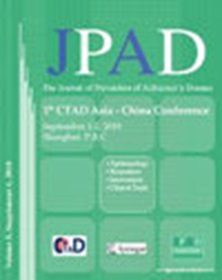比较标准版和电子版的阿尔茨海默病评估量表-认知子量表:一项验证研究
IF 8.5
3区 医学
Q1 CLINICAL NEUROLOGY
引用次数: 6
摘要
阿尔茨海默病评估量表(ADAS-Cog)已成为评估推定的抗痴呆治疗效果的事实上的黄金标准。人们对为规模提供更大的标准化、自动化和管理一致性越来越感兴趣。最近,电子版本的ADAS-Cog (eADAS-Cog)已用于临床试验,并证明与纸质版本相比,评估错误的频率显著降低。为了建立电子版本(eADAS-Cog)的有效性,20名在美国一家私人记忆诊所接受可能阿尔茨海默病(AD)诊断的受试者完成了一项单中心、随机、平衡、前瞻性试验,将eADAS-Cog版本与标准纸质量表进行比较。总分的类间相关系数与领域得分的Kappa分析结果一致(0.88-0.99)。给药顺序和给药方式对ADAS-Cog总分的影响不存在显著的主效应。总的来说,本研究在诊断为AD的成年人群中建立了ADAS-Cog和eADAS-Cog之间足够的并发有效性。本文章由计算机程序翻译,如有差异,请以英文原文为准。
Comparing the Standard and Electronic Versions of the Alzheimer’s Disease Assessment Scale — Cognitive Subscale: A Validation Study
The Alzheimer’s Disease Assessment Scale (ADAS-Cog) has become the de facto gold-standard for assessing the efficacy of putative anti-dementia treatments. There has been an increasing interest in providing greater standardization, automation, and administration consistency to the scale. Recently, electronic versions of the ADAS-Cog (eADAS-Cog) have been utilized in clinical trials and demonstrated significant reductions in frequency of rater error as compared to paper. In order to establish validity of the electronic version (eADAS-Cog), 20 subjects who had received a diagnosis of probable Alzheimer’s disease (AD) at a private US Memory Clinic completed a single-center, randomized, counterbalanced, prospective trial comparing a version of the eADAS-Cog to the standard paper scale. Interclass Correlation Coefficient on total scores and Kappa analysis on domain scores yielded high agreement (0.88–0.99). Effects of order and mode of administration on ADAS-Cog total scores did not demonstrate a significant main effect. Overall, this study establishes adequate concurrent validity between the ADAS-Cog and eADAS-Cog among an adult population with diagnosed AD.
求助全文
通过发布文献求助,成功后即可免费获取论文全文。
去求助
来源期刊

Jpad-Journal of Prevention of Alzheimers Disease
CLINICAL NEUROLOGY-
自引率
7.80%
发文量
85
期刊介绍:
The JPAD « Journal of Prevention of Alzheimer’Disease » will publish reviews, original research articles and short reports to improve our knowledge in the field of Alzheimer prevention including : neurosciences, biomarkers, imaging, epidemiology, public health, physical cognitive exercise, nutrition, risk and protective factors, drug development, trials design, and heath economic outcomes.
JPAD will publish also the meeting abstracts from Clinical Trial on Alzheimer Disease (CTAD) and will be distributed both in paper and online version worldwide.
 求助内容:
求助内容: 应助结果提醒方式:
应助结果提醒方式:


